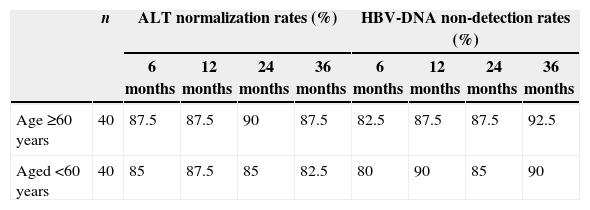Chronic infection with hepatitis B virus (CHB) affects as many as 350–400 million people worldwide and 93 million people in China.1 Moreover, elderly patients with CHB are increasing. Hence, the treatment of elderly patients with CHB is an important issue. However, to our knowledge, there is no report about the efficacy of Entecavir (ETV) treatment on elderly patients (≥60 years) with CHB.
A retrospective cohort study was conducted between February 2006 and March 2008; 40 consecutive Chinese patients aged ≥60 years were enrolled in this study at Zhenjiang No. 3 Hospital. We also selected 40 patients aged <60 years with CHB on ETV therapy at same time, who were matched to the ≥60 age group with respect to sex, alanine aminotransferase (ALT), HBV-DNA level, HBV genotype, and HBeAg status and duration of therapy. The study protocol was approved by the ethics committees of the hospital. All patients were treated with Entecavir at a dose of 0.5mg/day peroral.
Table 1 shows the rates of normalization of ALT level and non-detection of HBV-DNA, among patients aged ≥60 years and <60 years after six months and three years on ETV therapy. The rates of ALT normalization of and of non-detection of HBV-DNA in the two groups were similar (p>0.05 for the two comparisons). Thirteen aged ≥60 years and nine patients aged less than 60 years underwent long-term liver biopsy (median time: 23 months, range: 12–39 months). Histological improvement (over 2-point decrease in the Knodell necroinflammatory score and no worsening of the Knodell fibrosis score) were 76.9% (10/13) versus 77.8% (7/9) and fibrosis improvement (the Ishak fibrosis score ≥1-point decrease) were 38.5% (5/13) versus 44.4%(4/9) in two groups, respectively (p>0.05 for the two comparisons).
Rates of ALT normalization and of non-detection of HBV-DNA in patients aged ≥60 years and <60 years.
| n | ALT normalization rates (%) | HBV-DNA non-detection rates (%) | |||||||
|---|---|---|---|---|---|---|---|---|---|
| 6 months | 12 months | 24 months | 36 months | 6 months | 12 months | 24 months | 36 months | ||
| Age ≥60 years | 40 | 87.5 | 87.5 | 90 | 87.5 | 82.5 | 87.5 | 87.5 | 92.5 |
| Aged <60 years | 40 | 85 | 87.5 | 85 | 82.5 | 80 | 90 | 85 | 90 |
The cumulative emergence rates of ETV resistance in patients aged ≥60 years and in those <60 years were 0% and 0% at one year, 2.5% and 0% at two years, and 2.5% and 2.5% at three years, respectively. The emergence rates of ETV resistance in patients aged ≥60 years were similar to those of patients aged <60 years at all three time intervals. The cumulative rates of breakthrough hepatitis in patients aged ≥60 and <60 years were 0% and 0% at one year, 2.5% and 0% at two years, and 2.5% and 2.5% at three years, respectively (not significant). The mutation clusters were rtI169T+rtL180M+rtM204V+rtM250V and rtL180M+rtT184G+rtS202I, and rtM204V, respectively. After emergence of the HBV mutant, we added adefovir dipivoxil (ADV) to ongoing ETV therapy.
The benefits of ETV in patients with compensated HBV-related liver disease have been suggested by several groups.2–5 Our study is the first to show long-term efficacy of ETV monotherapy in older patients. Our results suggest that the treatment with ETV is not only well tolerated but also effective in the elderly population with chronic HBV infection.
Further studies are needed to confirm the efficacy and safety of ETV among the elderly.
Conflicts of interestThe authors declare no conflicts of interest.





